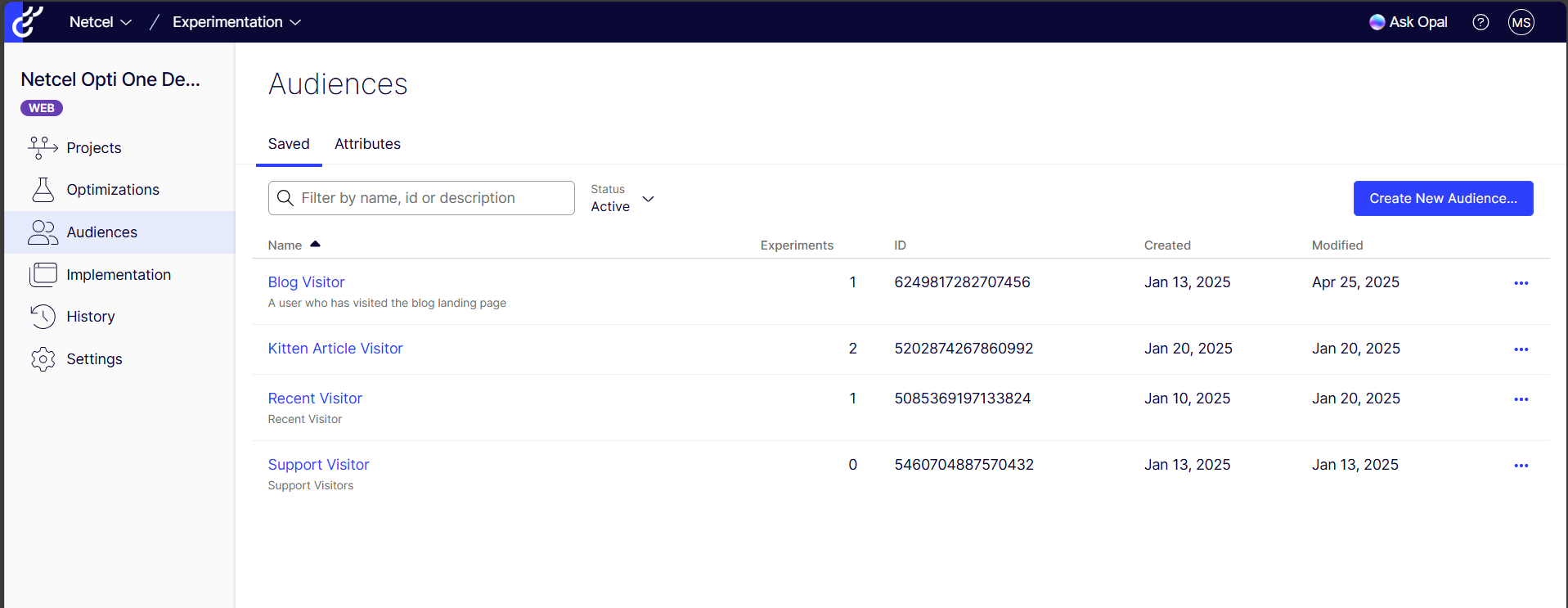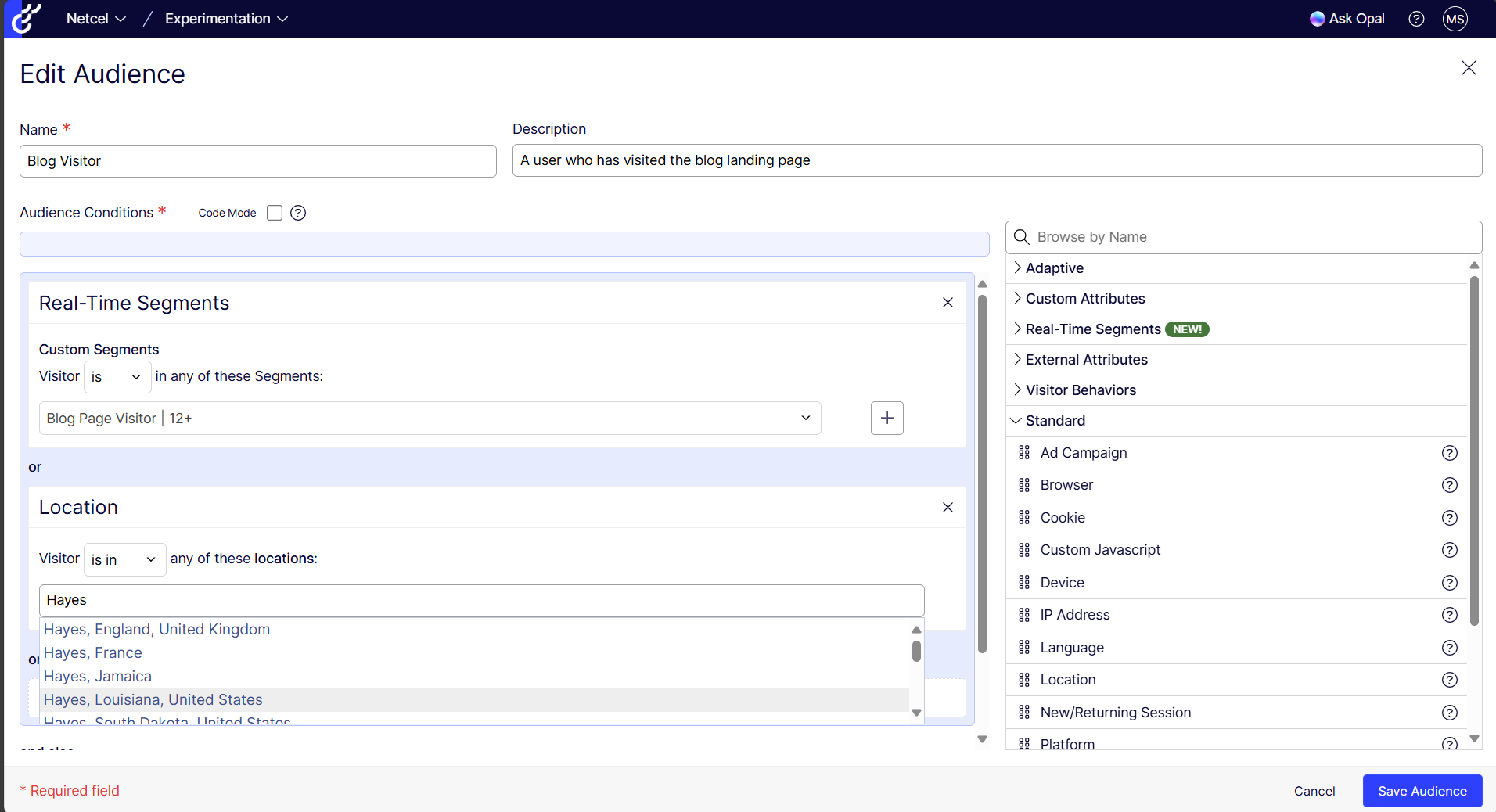Step 17 of 36 (47% complete)
Audiences
What are Audiences?
Audiences in Optimizely Experimentation allow you to target specific groups of users for your experiments and personalization campaigns. By defining audiences, you ensure that your tests reach the right people at the right time, improving the relevance and effectiveness of your optimization efforts.


Basic Audiences
Basic audiences are created using simple targeting conditions based on visitor attributes and behaviors that can be evaluated when the visitor first arrives on your site.
Common Basic Audience Examples
Geographic Targeting
- Country: Target visitors from specific countries
- Region/State: Focus on particular regions or states
- City: Target users from specific metropolitan areas
- Timezone: Customize experiences based on time zones
Device and Browser Targeting
- Device Type: Mobile, tablet, or desktop users
- Operating System: iOS, Android, Windows, macOS
- Browser: Chrome, Safari, Firefox, Edge
- Screen Resolution: Target based on screen size
Traffic Source Targeting
- Referrer: Target visitors from specific websites
- Campaign Source: UTM campaign parameters
- Search Keywords: Organic search terms
- Direct Traffic: Visitors who typed your URL directly
Time-Based Targeting
- Day of Week: Target specific days (weekends vs weekdays)
- Time of Day: Target specific hours
- Date Range: Time-limited campaigns
Creating Basic Audiences
- Navigate to Audiences: Go to the Audiences section in your Optimizely project
- Create New Audience: Click "Create Audience" and select "Basic Audience"
- Define Conditions: Add targeting conditions using the visual editor
- Set Logic: Choose AND/OR logic for multiple conditions
- Test and Save: Preview your audience and save the configuration
Advanced Audiences: Real-Time Segments
Real-time segments take audience targeting to the next level by using dynamic customer data from Optimizely Data Platform (ODP). These audiences update in real-time based on user behavior and can leverage rich customer profiles.
Benefits of Real-Time Segments
- Dynamic Updates: Audiences change as user behavior evolves
- Rich Data: Access to complete customer profiles and behavior history
- Cross-Channel Consistency: Same segments used across all Optimizely products
- Behavioral Targeting: Target based on past actions and preferences
ODP Integration for Enhanced Targeting
When connected to Optimizely Data Platform, you can create sophisticated audiences based on:
Customer Lifecycle Stages
- New Visitors: First-time website visitors
- Returning Customers: Users with previous purchases
- VIP Customers: High-value customers based on lifetime value
- At-Risk Customers: Users showing churn indicators
Behavioral Segments
- Product Interest: Users who viewed specific product categories
- Cart Abandoners: Visitors who added items but didn't complete purchase
- Frequent Browsers: Users with high engagement but low conversion
- Seasonal Shoppers: Customers active during specific periods
Purchase History Segments
- High-Value Customers: Based on order value thresholds
- Category Buyers: Customers who purchase from specific categories
- Discount Seekers: Users who primarily purchase with promotions
- Subscription Customers: Active subscribers vs one-time buyers
Example Real-Time Segment Use Cases
High-Value Customer Experience
Target customers with lifetime value over $1000 for:
- Premium product recommendations
- Exclusive offers or early access
- White-glove customer service options
Cart Abandonment Recovery
Target users who abandoned their cart in the last 24 hours with:
- Different discount offers to complete purchase
- Shipping incentives vs percentage discounts
- Urgency messaging experiments
Geographic + Behavioral Targeting
Target mobile users in urban areas who browse electronics to test:
- Mobile-optimized product displays
- Location-based inventory and pickup options
- Mobile payment method experiments
Audience Targeting Best Practices
1. Start Simple, Then Scale
- Begin with basic demographic and geographic audiences
- Add behavioral segments as you collect more data
- Gradually implement more sophisticated targeting
2. Ensure Sufficient Sample Size
- Audiences that are too narrow may not have enough traffic for statistical significance
- Monitor audience size before launching experiments
- Consider broadening criteria if sample sizes are too small
3. Avoid Over-Segmentation
- Don't create too many overlapping audiences
- Focus on meaningful differences between segments
- Test one audience dimension at a time when possible
4. Regular Audience Review
- Monitor audience performance over time
- Update criteria based on changing business needs
- Remove or consolidate underperforming audiences
5. Cross-Platform Consistency
- Use the same audience definitions across Web and Feature Experimentation
- Ensure consistent experiences for users across touchpoints
- Leverage ODP segments for unified customer experiences
Audience Analytics and Insights
Performance Monitoring
- Conversion Rates: Track how different audiences perform
- Engagement Metrics: Monitor time on site, pages per session
- Revenue Impact: Measure financial outcomes by audience
- Experiment Participation: See which audiences engage with tests
Audience Overlap Analysis
- Identify users who belong to multiple segments
- Understand audience intersections and exclusions
- Optimize targeting to reduce conflicts between experiments
Refinement Opportunities
- Use performance data to refine audience criteria
- Identify high-performing sub-segments for further testing
- Discover unexpected patterns in user behavior
Getting Started with Audiences
Phase 1: Basic Implementation
- Create geographic and device-based audiences
- Set up traffic source targeting
- Implement time-based audiences for seasonal campaigns
Phase 2: Behavioral Enhancement
- Integrate with Optimizely Data Platform
- Create customer lifecycle segments
- Build purchase history-based audiences
Phase 3: Advanced Optimization
- Implement real-time behavioral triggers
- Create predictive audience segments
- Develop cross-channel audience synchronization
Conclusion
Audiences are fundamental to successful experimentation and personalization. By starting with basic targeting and progressively implementing real-time segments powered by ODP, you can create highly relevant experiences that drive better engagement and conversion rates.
The key is to balance precision with practicality—create audiences that are specific enough to be meaningful but broad enough to generate actionable insights from your experiments.
Have questions? I'm here to help!
